City Contours Bonn
Who says Bonn is boring?

Is Bonn truly overshadowed by Cologne, and does the former German capital have an identity crisis? Our author Leonie Gubela explains what makes Bonn unique and why some assumptions about it could use a rethink.
By Leonie Gubela
Cherry blossoms and cobblestones
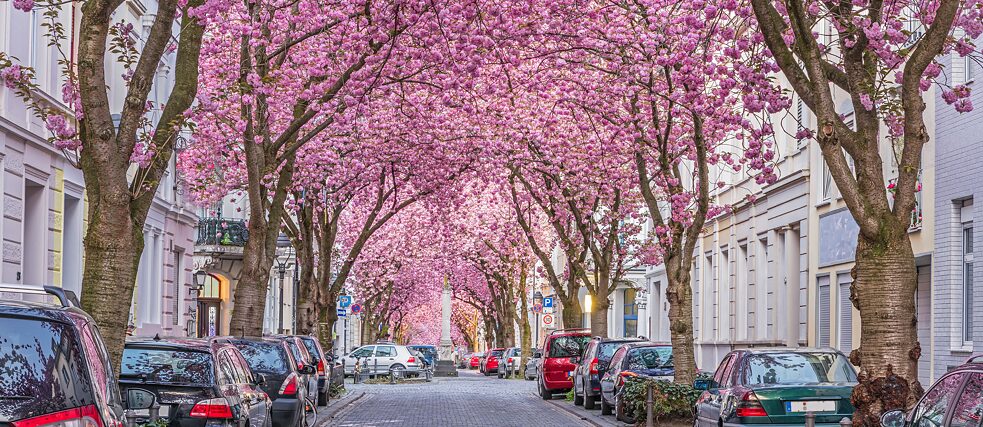 A canopy of pink: Bonn’s historic city centre with the cherry trees in full bloom.
| Photo (detail): © Adobe
Bonn’s historic centre is filled with winding alleyways, listed Wilhelminian-style buildings, pubs, and artist studios. Between mid-April and the end of May, it becomes a hotspot for Instagrammers when Heerstrasse is covered by a dense, pink canopy of blooming cherry trees. More ambitious photographers can enter cherry blossom photo competitions and those who do not want to chance missing the narrow window when the trees burst into glorious bloom can follow their progress via newsletter. Along with the pink season, attractions here include the sumptuous pizzas served at Tuscolo restaurant on Frankenbad and the Frauenmuseum (Women’s Museum). Far from the hustle and bustle of the city centre, the Alte Friedhof (Old Cemetery) with its crooked, moss-covered gravestones offers a spot for quiet contemplation.
A canopy of pink: Bonn’s historic city centre with the cherry trees in full bloom.
| Photo (detail): © Adobe
Bonn’s historic centre is filled with winding alleyways, listed Wilhelminian-style buildings, pubs, and artist studios. Between mid-April and the end of May, it becomes a hotspot for Instagrammers when Heerstrasse is covered by a dense, pink canopy of blooming cherry trees. More ambitious photographers can enter cherry blossom photo competitions and those who do not want to chance missing the narrow window when the trees burst into glorious bloom can follow their progress via newsletter. Along with the pink season, attractions here include the sumptuous pizzas served at Tuscolo restaurant on Frankenbad and the Frauenmuseum (Women’s Museum). Far from the hustle and bustle of the city centre, the Alte Friedhof (Old Cemetery) with its crooked, moss-covered gravestones offers a spot for quiet contemplation.
Beton für Bonn (Cement for Bonn)
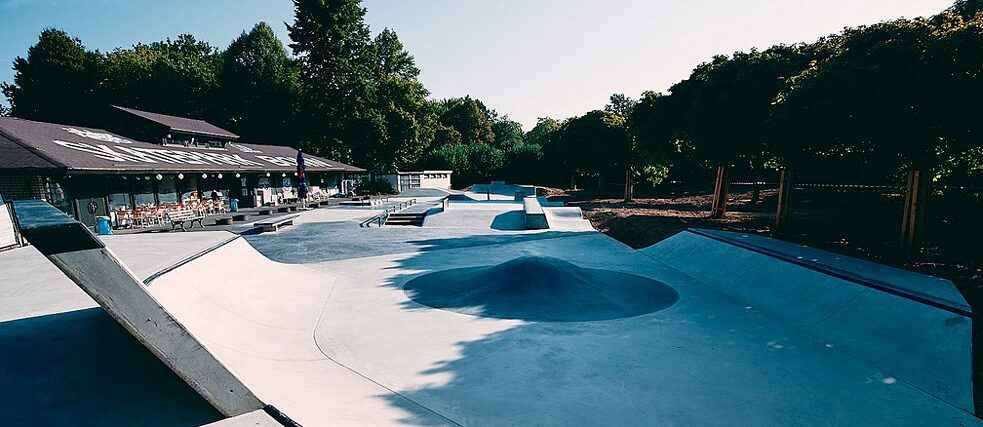 Bonn skater part in the Rheinaue wetlands.
| Photo (detail): © Beton für Bonn
For four years, the Subculture Bonn association organized fundraising events and concerts, held raffles, sold merchandise and fought to attract investors as part of its Beton für Bonn (Cement for Bonn) initiative. By summer 2018, the time had finally come for Bonn’s first skate park to open in the Rheinaue wetlands in Beuel. Before the new park was built, a halfpipe on the other side of the Rhine, and much too tricky for beginners, had been the only place to skate. Subculture members wanted something larger for their city so Bonn’s skaters would not have to head into the outskirts to pursue their craft.
Bonn skater part in the Rheinaue wetlands.
| Photo (detail): © Beton für Bonn
For four years, the Subculture Bonn association organized fundraising events and concerts, held raffles, sold merchandise and fought to attract investors as part of its Beton für Bonn (Cement for Bonn) initiative. By summer 2018, the time had finally come for Bonn’s first skate park to open in the Rheinaue wetlands in Beuel. Before the new park was built, a halfpipe on the other side of the Rhine, and much too tricky for beginners, had been the only place to skate. Subculture members wanted something larger for their city so Bonn’s skaters would not have to head into the outskirts to pursue their craft.
Hofgarten and gummi bears
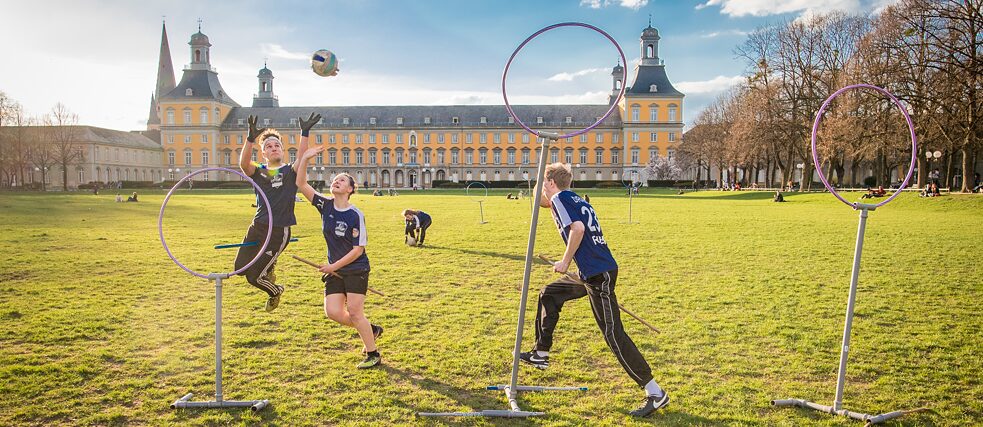 While the Harry Potter craze may have ebbed, quidditch is still played in Bonn’s Hofgarten.
| Photo (detail): © picture alliance/dpa/ Volker Lannert
Students sleep amongst taut slacklines (a kind of tightrope stretched between two trees), a couple of guys strum guitars and the local Quidditch team practices alongside the ultimate frisbee club on the back third of the park: the Hofgarten (Court Garden) in front of the university’s main building could hardly seem more carefree on an average summer’s day. The local park once belonged to Prince-Elector Clemens August’s residence and has survived a somewhat turbulent past. Immediately following the Second World War, the area served as a transit camp for freed prisoners of war. Years later, when Bonn was the German capital, hundreds of thousands repeatedly gathered there to demonstrate, protesting the 1968 Germany Emergency Acts and NATO’s Double-Track Decision in the early eighties. Today, people relax in the sunshine, go for walks and, some say, deal illicit substances at night. These probably do not include gummi bears, since these are available quite legally just a few meters from the Hofgarten in Germany’s first Haribo store. And every child knows what the ‘bo’ at the end of the sweet treat’s name stands for, right? (For everyone not from Bonn: The name was derived from the founder’s name and hometown, HAns RIegel from BOnn.)
While the Harry Potter craze may have ebbed, quidditch is still played in Bonn’s Hofgarten.
| Photo (detail): © picture alliance/dpa/ Volker Lannert
Students sleep amongst taut slacklines (a kind of tightrope stretched between two trees), a couple of guys strum guitars and the local Quidditch team practices alongside the ultimate frisbee club on the back third of the park: the Hofgarten (Court Garden) in front of the university’s main building could hardly seem more carefree on an average summer’s day. The local park once belonged to Prince-Elector Clemens August’s residence and has survived a somewhat turbulent past. Immediately following the Second World War, the area served as a transit camp for freed prisoners of war. Years later, when Bonn was the German capital, hundreds of thousands repeatedly gathered there to demonstrate, protesting the 1968 Germany Emergency Acts and NATO’s Double-Track Decision in the early eighties. Today, people relax in the sunshine, go for walks and, some say, deal illicit substances at night. These probably do not include gummi bears, since these are available quite legally just a few meters from the Hofgarten in Germany’s first Haribo store. And every child knows what the ‘bo’ at the end of the sweet treat’s name stands for, right? (For everyone not from Bonn: The name was derived from the founder’s name and hometown, HAns RIegel from BOnn.)
Luxury camping in a depot
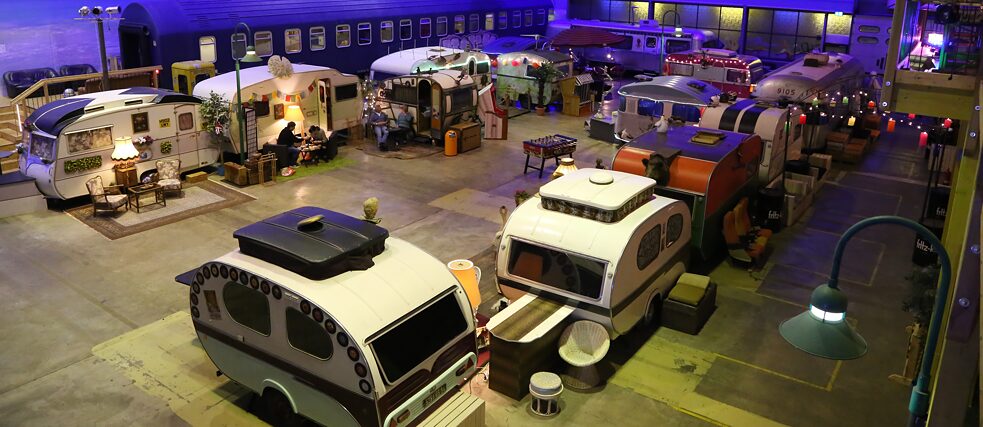 Basecamp, Bonn’s indoor campground.
| Photo (detail): © Basecamp
A former depot in Bonn-Dottendorf is idea for anyone who enjoys the comfort of a motorhome, but can do without the inconvenience of a camping stove, porta potty and the capriciousness of the great outdoors. Indoor campsite Basecamp has over a dozen elaborately renovated retro caravans with unusual designs. Group travellers can spend the night in sleeping cars scrapped by the Deutsche Bahn. Just like in a hotel, there is a breakfast buffet every morning for the up to 120 overnight guests and the beds are made up fresh every day. It is even a wedding venue – assuming that the Caribbean photo wallpaper that adorns the depot’s walls is not too kitschy for the bridal couple.
Basecamp, Bonn’s indoor campground.
| Photo (detail): © Basecamp
A former depot in Bonn-Dottendorf is idea for anyone who enjoys the comfort of a motorhome, but can do without the inconvenience of a camping stove, porta potty and the capriciousness of the great outdoors. Indoor campsite Basecamp has over a dozen elaborately renovated retro caravans with unusual designs. Group travellers can spend the night in sleeping cars scrapped by the Deutsche Bahn. Just like in a hotel, there is a breakfast buffet every morning for the up to 120 overnight guests and the beds are made up fresh every day. It is even a wedding venue – assuming that the Caribbean photo wallpaper that adorns the depot’s walls is not too kitschy for the bridal couple.
Politics from the past to the present
 The lighthouses of the Federal Republic of Germany’s museum and exhibition hall.
| Photo (detail): © picture alliance/ imageBROKER/ Karl F. Schöfmann
Bonn’s Haus der Geschichte (House of History) is a place for visitors to experience Germany’s post-war history up close and personal. Cover decades of fascinating history in minutes by walking through the hold of one of the famous “raisin bombers” involved in the Berlin airlift, past the green, upholstered folding chairs from the Bundestag in the fifties into a replica of a historic cinema for a short screening of the locally made film Grün ist die Heide (the Heath is Green). Place your hand on the cold cement of the Berlin Wall and walk up a steep ramp to the moon. The House of History is one of five museums that together form Bonn’s Museum Mile. It stretches along the Bundesstraße 9 and covers natural history (Museum König), history (Haus der Geschichte), art (Kunstmuseum Bonn), more art (Bundeskunsthalle) and technology (Deutsches Museum). The UN Campus, the United Nations central offices in Germany, is just across the road. Only in Bonn do the political events of past and present run parallel separated by a four-lane thoroughfare.
The lighthouses of the Federal Republic of Germany’s museum and exhibition hall.
| Photo (detail): © picture alliance/ imageBROKER/ Karl F. Schöfmann
Bonn’s Haus der Geschichte (House of History) is a place for visitors to experience Germany’s post-war history up close and personal. Cover decades of fascinating history in minutes by walking through the hold of one of the famous “raisin bombers” involved in the Berlin airlift, past the green, upholstered folding chairs from the Bundestag in the fifties into a replica of a historic cinema for a short screening of the locally made film Grün ist die Heide (the Heath is Green). Place your hand on the cold cement of the Berlin Wall and walk up a steep ramp to the moon. The House of History is one of five museums that together form Bonn’s Museum Mile. It stretches along the Bundesstraße 9 and covers natural history (Museum König), history (Haus der Geschichte), art (Kunstmuseum Bonn), more art (Bundeskunsthalle) and technology (Deutsches Museum). The UN Campus, the United Nations central offices in Germany, is just across the road. Only in Bonn do the political events of past and present run parallel separated by a four-lane thoroughfare.
Viva Viktoria!
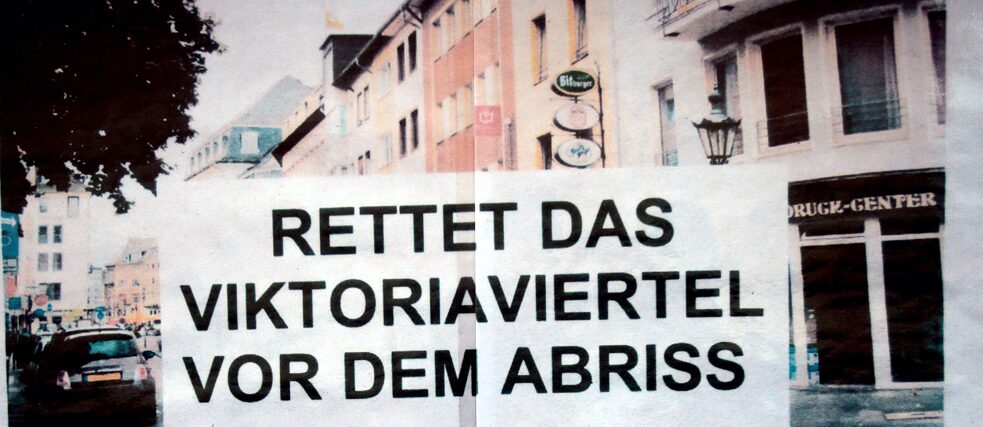 No shopping mall here: the “Viva Viktoria!” citizen’s initiative kicked off a successful movement against construction plans. This poster was pinned to the closed Viktoria Bath's wall in 2015.
| Photo (detail): © picture alliance / Oliver Berg / dpa
It takes a closer look to truly appreciate the Viktoria Quarter’s subtle beauty. It would be easy to walk by the colourful mosaic tiles that decorate the shop entrances in the quarter or overlook the lovely stained glass (actually synthetic resin) windows of the closed Viktoria Bath. With buildings from the fifties and sixties, the Viktoria links the city centre to the Hofgarten. A few years ago, Bonn announced its intention to sell some of the land to an Austrian investor who planned to build a shopping mall and a university library. The plans horrified many Bonn residents, who joined forces to form the Viva Viktoria! citizen’s initiative. They campaigned for “conservation instead of exploitation”, organized parties in the quarter, and kicked off a citizens’ petition for a referendum at the end of 2015. Their efforts were successful and the mall is no longer on the table, though it is still unclear how wide-reaching the scheduled refurbishment of the quarter will be.
No shopping mall here: the “Viva Viktoria!” citizen’s initiative kicked off a successful movement against construction plans. This poster was pinned to the closed Viktoria Bath's wall in 2015.
| Photo (detail): © picture alliance / Oliver Berg / dpa
It takes a closer look to truly appreciate the Viktoria Quarter’s subtle beauty. It would be easy to walk by the colourful mosaic tiles that decorate the shop entrances in the quarter or overlook the lovely stained glass (actually synthetic resin) windows of the closed Viktoria Bath. With buildings from the fifties and sixties, the Viktoria links the city centre to the Hofgarten. A few years ago, Bonn announced its intention to sell some of the land to an Austrian investor who planned to build a shopping mall and a university library. The plans horrified many Bonn residents, who joined forces to form the Viva Viktoria! citizen’s initiative. They campaigned for “conservation instead of exploitation”, organized parties in the quarter, and kicked off a citizens’ petition for a referendum at the end of 2015. Their efforts were successful and the mall is no longer on the table, though it is still unclear how wide-reaching the scheduled refurbishment of the quarter will be.
Drop towers and castle ruins
 View on Schloss Drachenburg: Drachenfels hill (Dragon Rock) is the most popular excursion destination in the Siebengebirge.
| Photo (detail): © Adobe
A boat from Bonn will take you in either direction along the Rhine River, and the upriver and downriver attractions could not be more different. On a trip downstream chemical plants, an oil refinery and the Phantasialand amusement park flow by, while upstream takes you into the Siebengebirge (Seven Mountains) where castle ruins and plenty of Rhine romanticism replace smokestacks and drop towers. The most popular excursion destination is the Drachenfels (Dragon Rock) between Königswinter and Bad Honnef. A dragon is said to have lived atop the 320-metre outcropping, from where it used to swoop down and terrorize the people of the Rhine valley centuries ago. Residents reportedly sacrificed a virgin to the beast every year to appease it until Siegfried (the hero from the epic poem Nibelungenlied or Song of the Nibelungs) rode up on his steed, slayed the beast and bathed in its blood. All traces of this heroic act of derring-do have since disappeared and Drachenfels is a popular destination for conferences and landscape painters. Ride to the top in comfort on the oldest rack railway in Germany or on the back of a donkey. You can even see Cologne Cathedral in the distance in good weather.
View on Schloss Drachenburg: Drachenfels hill (Dragon Rock) is the most popular excursion destination in the Siebengebirge.
| Photo (detail): © Adobe
A boat from Bonn will take you in either direction along the Rhine River, and the upriver and downriver attractions could not be more different. On a trip downstream chemical plants, an oil refinery and the Phantasialand amusement park flow by, while upstream takes you into the Siebengebirge (Seven Mountains) where castle ruins and plenty of Rhine romanticism replace smokestacks and drop towers. The most popular excursion destination is the Drachenfels (Dragon Rock) between Königswinter and Bad Honnef. A dragon is said to have lived atop the 320-metre outcropping, from where it used to swoop down and terrorize the people of the Rhine valley centuries ago. Residents reportedly sacrificed a virgin to the beast every year to appease it until Siegfried (the hero from the epic poem Nibelungenlied or Song of the Nibelungs) rode up on his steed, slayed the beast and bathed in its blood. All traces of this heroic act of derring-do have since disappeared and Drachenfels is a popular destination for conferences and landscape painters. Ride to the top in comfort on the oldest rack railway in Germany or on the back of a donkey. You can even see Cologne Cathedral in the distance in good weather.
Variety instead of adult education classes
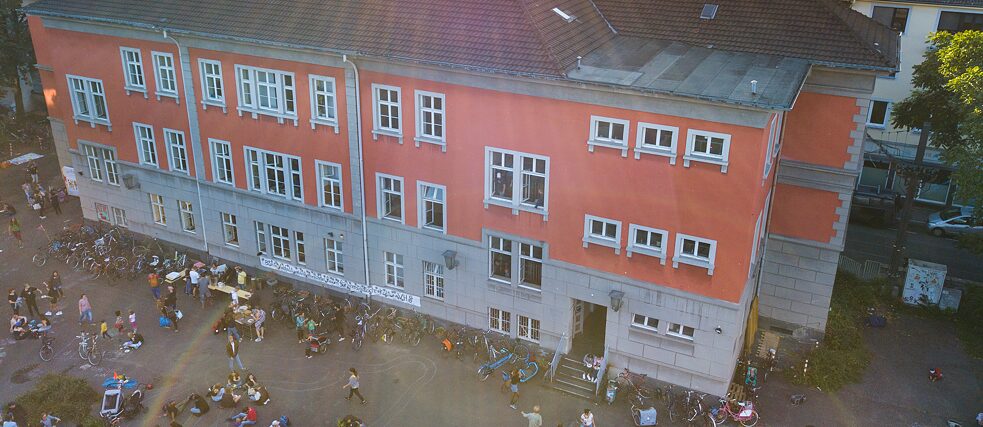 “Alte VHS”: the building formerly occupied by an adult education centre is now a liberal cultural centre.
| Photo (detail): © Alte VHS
Lectures are a thing of the past in the building that once housed the local adult education centre. The Rhizom association turned the empty classrooms into the Alte VHS cultural centre, where discussions on the final stages in phasing out coal, feminist workshops and jam sessions are now on the curriculum. Supported by donations and staffed by volunteers, the Alte VHS centre offers a silk-screening workshop, a vinyl record exchange and a kid-chaos room along with courses ranging from laughter yoga to kickboxing.
“Alte VHS”: the building formerly occupied by an adult education centre is now a liberal cultural centre.
| Photo (detail): © Alte VHS
Lectures are a thing of the past in the building that once housed the local adult education centre. The Rhizom association turned the empty classrooms into the Alte VHS cultural centre, where discussions on the final stages in phasing out coal, feminist workshops and jam sessions are now on the curriculum. Supported by donations and staffed by volunteers, the Alte VHS centre offers a silk-screening workshop, a vinyl record exchange and a kid-chaos room along with courses ranging from laughter yoga to kickboxing.
From Beethoven to German chancellors
 Ludwig Beethoven surrounded by 700 doubles: this art instillation was set up in honour of the composer’s 250th birthday.
| Photo (detail): © picture alliance/ Sven Simon
Bonn is proud of Beethoven, its native son, who is memorialised in and around the Münsterplatz. Perched on an impressive pedestal in front of the post office, pad in hand to compose a symphony, he looks out over the square with a serious expression. His likeness also graces the Stadtgarten, though in a more modern incarnation. The concert hall on the banks of the Rhine bears his name, of course, and the Beethoven Festival celebrates his life’s work every year with numerous concerts and events. Other famous personalities have also shaped the cityscape, including a number of German chancellors. Following the Second World War, Bonn was the seat of government of the Federal Republic of Germany from 1949 to 1999. A total of seven German chancellors lived here at one time or another. A bronze sculpture of the first Chancellor of the Federal Republic stands in front of the former Federal Chancellery on the aptly named Adenauerallee with images from his eventful life shaped into the back of the bust. The Willy Brandt Villa is located in the Venusberg district. The two Helmuts who served as chancellors have been honoured in a less glamorous way: Schmidt has his own roundabout on the B9, and the 400-metre-long section of road leading to it was recently named after Helmut Kohl.
Ludwig Beethoven surrounded by 700 doubles: this art instillation was set up in honour of the composer’s 250th birthday.
| Photo (detail): © picture alliance/ Sven Simon
Bonn is proud of Beethoven, its native son, who is memorialised in and around the Münsterplatz. Perched on an impressive pedestal in front of the post office, pad in hand to compose a symphony, he looks out over the square with a serious expression. His likeness also graces the Stadtgarten, though in a more modern incarnation. The concert hall on the banks of the Rhine bears his name, of course, and the Beethoven Festival celebrates his life’s work every year with numerous concerts and events. Other famous personalities have also shaped the cityscape, including a number of German chancellors. Following the Second World War, Bonn was the seat of government of the Federal Republic of Germany from 1949 to 1999. A total of seven German chancellors lived here at one time or another. A bronze sculpture of the first Chancellor of the Federal Republic stands in front of the former Federal Chancellery on the aptly named Adenauerallee with images from his eventful life shaped into the back of the bust. The Willy Brandt Villa is located in the Venusberg district. The two Helmuts who served as chancellors have been honoured in a less glamorous way: Schmidt has his own roundabout on the B9, and the 400-metre-long section of road leading to it was recently named after Helmut Kohl.
Nightlife worth mentioning
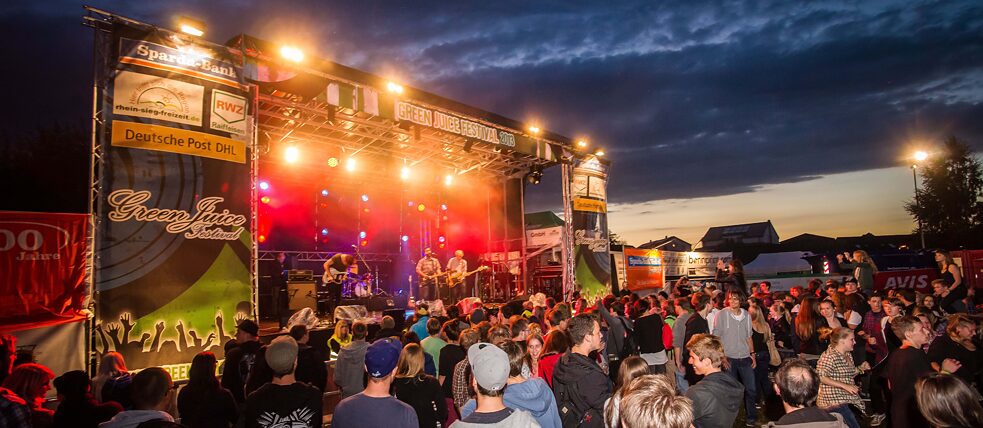 Apart from clubs and pubs, Bonn also offers several open-air festivals and concerts in summer, such as the Green Juice Festival here.
| Photo (detail): © Michael Sondermann / Bundesstadt Bonn
Bonn, the old joke goes, is an acronym for “Bundesstadt ohne nennenswertes Nachtleben” (federal city with no nightlife worthy of mention). This is probably because it pales in comparison to the goings-on in nearby Cologne, home to three times as many people. The options on offer in Bonn are pleasantly limited, so they draw you out instead of pinning you to the sofa in a flurry of indecision. A typical Friday night might start with a Mexikaner cocktail (similar to a Bloody Mary, only spicier and smaller) in Babel, a few “Wegbiere” from Aksoy in the Vorgebirgstraße (a “Wegbier” is a beer to go purchased in a kiosk, also called a “Büdchen” in Bonn, and meant to be drunk on the walk to the next club or bar) followed by a few hours of dancing, maybe in Untergrund, perhaps in Blow Up and possibly in Carpe. Then a few calories consumed in Cala Dor pizzeria provide the strength to hit the final stop: the Wache in the historic city centre, is always open.
Apart from clubs and pubs, Bonn also offers several open-air festivals and concerts in summer, such as the Green Juice Festival here.
| Photo (detail): © Michael Sondermann / Bundesstadt Bonn
Bonn, the old joke goes, is an acronym for “Bundesstadt ohne nennenswertes Nachtleben” (federal city with no nightlife worthy of mention). This is probably because it pales in comparison to the goings-on in nearby Cologne, home to three times as many people. The options on offer in Bonn are pleasantly limited, so they draw you out instead of pinning you to the sofa in a flurry of indecision. A typical Friday night might start with a Mexikaner cocktail (similar to a Bloody Mary, only spicier and smaller) in Babel, a few “Wegbiere” from Aksoy in the Vorgebirgstraße (a “Wegbier” is a beer to go purchased in a kiosk, also called a “Büdchen” in Bonn, and meant to be drunk on the walk to the next club or bar) followed by a few hours of dancing, maybe in Untergrund, perhaps in Blow Up and possibly in Carpe. Then a few calories consumed in Cala Dor pizzeria provide the strength to hit the final stop: the Wache in the historic city centre, is always open.
city contours
Allotments in Berlin or skinny-dipping in Munich: come and explore some German cities with us – also against the grain. We give you an outline of the classic places, communities and events that are an intrinsic part of the city profile – and we redraw the contours by challenging a few clichés.
Comments
Comment